
Figure 1. Examples of microscope slides that were prepared by Herbert W.H. Darlaston. His slides are often encountered without the circular maker’s label, although they are readily recognized by Darlaston’s handwriting and style of production.
Herbert William Hutton Darlaston, 1867 - 1949
by Brian Stevenson
last updated April, 2019
Herbert Darlaston developed an interest in nature and wildlife as a child, and bought his first microscope at around the age of twenty. In about 1887, he was introduced to a skillful amateur slide-maker, James W. Neville. Darlaston wrote in 1911, “Neville … showed me a glorious array of mounted slides, many of them parts of my favourite insects. I spent an afternoon with this gentleman and came away in a hot fever to do similar work. From that day I have mounted slides almost incessantly. Twelve months after the day of my visit I had mounted nearly a thousand slides. For twelve years it was my principle hobby, and during that time I must have made thousands of other slides, most of which I gave away to young beginners in this greatest of all hobbies. Then for several years I mounted slides in my leisure time, and disposed of them, to cover, or partly cover, my expenses. I found a ready sale for all the slides I could prepare. About five years ago (ca. 1905) I decided to give my whole time to this work, taking as my motto ‘a high-class slide at a low-cost price’.” Darlaston continued to professionally mount slides through the rest of his life. While his slides are still relatively common, they are, in the words of Brian Bracegirdle, “all of high quality”.

Figure 1.
Examples of microscope slides that were prepared by Herbert W.H. Darlaston. His slides are often encountered without the circular maker’s label, although they are readily recognized by Darlaston’s handwriting and style of production.

Figure 2.
H.W.H. Darlaston’s label. He lived in the Birchfield section of Birmingham for his entire 40+ year career as a slide-maker.
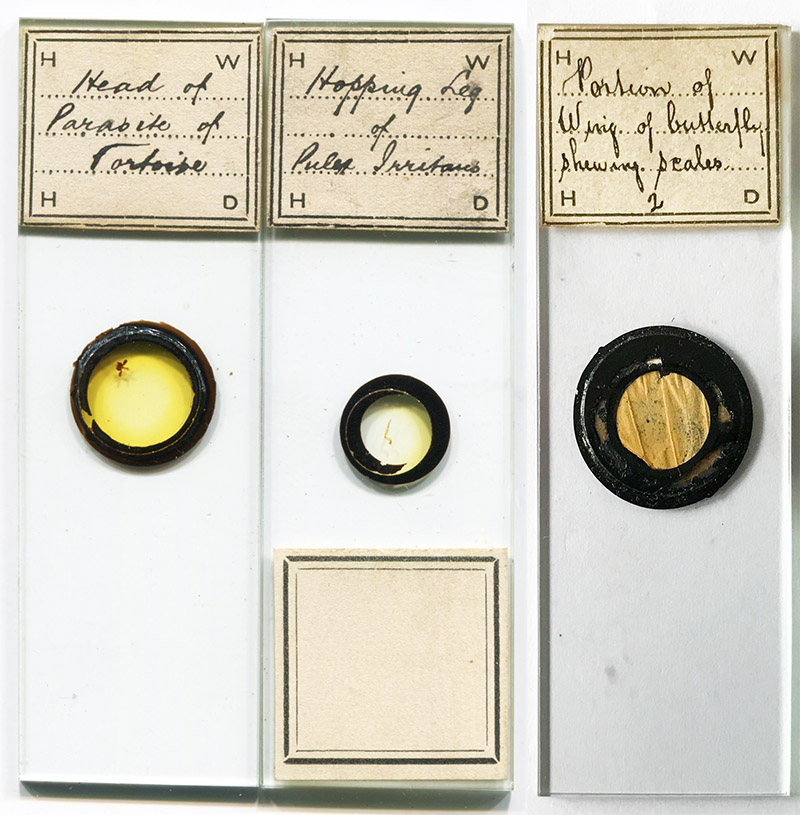
Figure 3.
Three uncommon slides with labels lettered “H W H D”, undoubtedly referring to H.W.H. Darlaston. But, the handwriting does not resemble Darlaston’s. However, the handwriting on the two leftmost slides is very much like that of fellow Birmingham slide-maker Richard Hancock. Both Darlaston and Hancock were simultaneously members of the Birmingham Microscopists’ and Naturalists’ Union. Thus a quandary: did Darlaston prepare these slides with his own label but leave it to his colleagues to write out the descriptions; or did Darlaston acquire them from colleagues, affix his own labels, yet ask them to write descriptions of the specimens; or was there some other scenario?
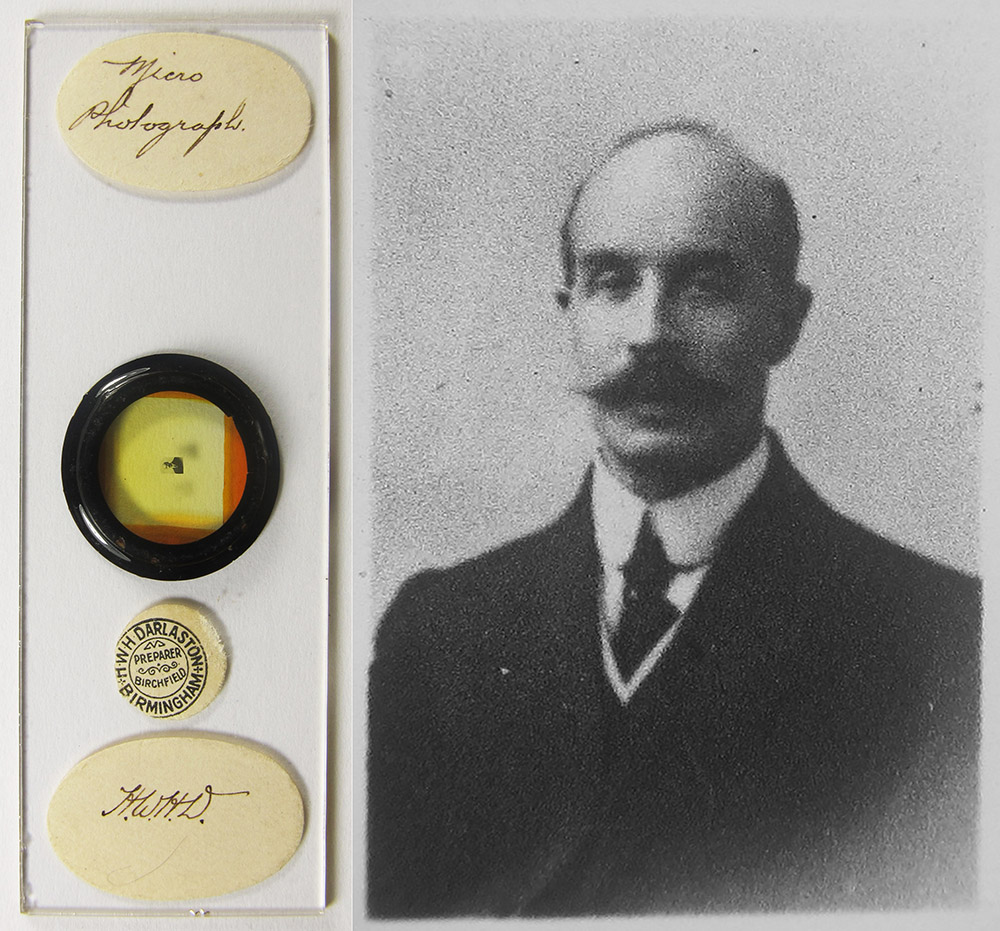


Figure 4.
Three rare microphotograph slides by Herbert Darlaston. The top photograph is of the preparer. The middle is of Herbert and his wife, Edith. The bottom photograph is presumably one of his two children, Eirene Mercy (born 1896) or Hilda Muriel (born 1901). Considering the personal nature of the photographs, it is probable that they were not mass-produced for commercial sale. Images courtesy of Trevor Gillingwater (top and bottom) and Richard Courtiour (middle).
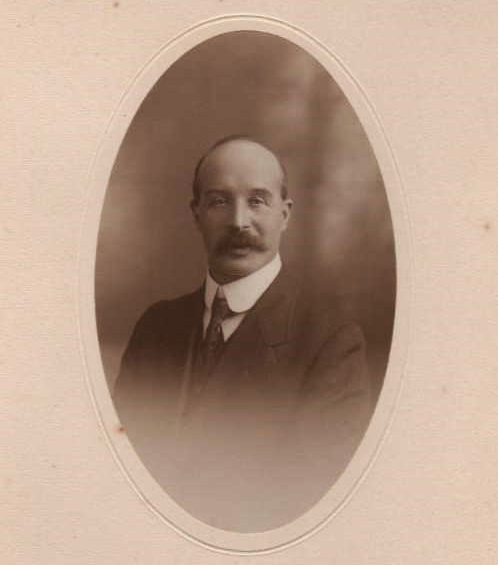
Figure 5.
Herbert William Hutton Darlaston. Adapted for educational, nonprofit purposes from an undated photograph on https://www.ancestry.co.uk/family-tree/person/tree/43657334/person/12687519217.
Herbert William Hutton Darlaston was the fourth child, and second son, of John and Susan Darlaston, born on April 8, 1867, in Aston, Warwickshire, England. Neither of his middle names were those of earlier family members, so it is likely that they derive from a friend of his parents. Herbert’s baptism record gave father John’s occupation as “gun implement maker”. The 1871 census listed John’s occupation as “merchant’s clerk”, while the 1881 census listed him as a “glass and lead merchant”. Herbert’s grandfather, also named John, was with the Darlastons at the time of the 1881 census, and was recorded as being a “gun smith”. While John Darlaston moved through a variety of occupations, the family evidently remained in good financial condition: one or more domestic servants were included in each census.
Herbert wrote, “I have been interested in natural history all my life. As a boy, most of my half holidays were spent away out in the country lanes and fields, where I learnt to know the wild birds by their calls, flights, and general appearance. My greatest attraction was for insects, though I never felt any particular attraction in collecting butterflies and moths”.
Nonetheless, Herbert Darlaston worked at clerical jobs for the first 35-odd years of his life. He was working for a musical instrument-maker at the time he met Neville. The 1891 census recorded him as being a “merchant’s clerk”, and the 1901 census listed his occupation as “accountant”.
Inspired by his interests in nature and his friendship with Neville, Darlaston joined the Birmingham Microscopists’ and Naturalist’s Union during the early 1890s. By 1893, he was serving as an Honourable Secretary to the society. He later served as Vice President (1907, 1910, and 1915) and President (1935).
Darlaston remained at his parents’ home of 109 Leonard Road, in the Handsworth area of Birmingham, until he married in the autumn of 1895. He and wife Edith (née Randall) moved a short distance to 10 Fentham Road, Birchfield, Birmingham. They had two daughters, Eirene Mercy (born 1896) and Hilda Muriel (born 1901).
A man of broad interests, Darlaston joined the British Astronomical Association in 1900.
The family moved to 20 Freer Street, Birchfield, Birmingham during 1901-1902 (Figure 14). Here, he established a used book shop in 1903. Curiously, the business used his middle names, William Hutton. Two requests in The Book Monthly indicate the type of books that Darlaston sold: “Quantity good, ancient or modern second-handbooks; especially want books on Oriental history and religion, also old books with coloured plates”, and, more specifically, “Clement Scott's From the Bells to King Arthur; Charles Hiatt's Henry Irving; Illustrated Souvenir of Irving's Dante, Drury Lane Theatre, 1903; Shifts and Expedients of Camp-life, by Lord and Barnes, 1862”. Records of the book shop end in 1906, around the time that Darlaston turned his full attention to slide-making.
As noted above, Darlaston produced slides commercially for several years before going into the business full-time. The earliest known advertisement for his microscopy business was published on December 5, 1902 (Figure 6). He resigned his clerical job in 1905-1906.
He joined the Birmingham Natural History and Philosophical Society in 1905, the Quekett Microscopical Club in 1906, and the Postal Microscopical Society in 1906. He served as President of the P.M.S. from 1912-1914.
Darlaston’s enthusiasm for making microscope slides led him to engineer at least two significant improvements in section-cutting. The Cathcart-Darlaston microtome and the Darlaston section-cutter were commercially produced by W. Watson & Sons from 1906 onward (Figure 7).
He began a distribution scheme in 1907. This was described by the Editor of Knowledge magazine, “Mr. H.W.H. Darlaston, of 20, Freer Road, Birchfield, Birmingham, has sent me particulars of a somewhat novel method of circulating slides. Briefly, the arrangement is that for a subscription of two guineas, 600 slides will be sent, post paid, in 12 monthly parcels of 50 slides each. From each monthly parcel five slides, 60 in all, may be selected and retained by the subscriber free, and he may also select further slides at an all-round price of 6d each. For a subscription of one guinea, 25 slides per month will be sent, and two per month retained, whilst for half a guinea twelve slides per month are sent, and one per month retained. Of the slides sent me as specimens I can speak highly; they are beautiful examples of the mounter's art, and in no way inferior to slides sold at double the price”. This was a relatively risk-free way for distant customers to acquire new slides through the post. It was also a clever marketing tool, since many customers would have difficult times in selecting only one slide out of twelve, or five out of fifty, and were likely to purchase several more from each set. Advertisements indicate that the subscription scheme was still in effect in 1910 (Figure 10).
Darlaston wrote, “I regularly send parcels of slides to subscribers to my circulating system as far as Australia”.
In 1911, he wrote, “I have a number of clients for whom I do regular mounting work in preparing slides from their own material. For several years I have done work for the Hon. N. Charles Rothschild”. Rothschild’s extensive flea collection is now housed in the Natural History Museum, London.
The Darlastons moved down the street in 1907, to 31 Freer Road (Figure 14). This is a larger house than number 20, probably reflecting the financial success of the slide-making business. The family remained at that address until 1940, when they moved to a smaller house at 8 Freer Road.
The slide-making business was still quite active at that time, despite Herbert being in his 70s. The 1940 Kelly’s Directory of Birmingham listed “Darlaston Herbert William Hutton, preparer of microscopic objects, 8 Freer road, Birchfield 6”. Alan Peacock’s 1940 book, Elementary Microtechnique, recommended “Darlaston, H.W.H., Freer Road, Birchfield, Birmingham (Micro, preps.; mounting customer's material)”. Julian Corrington’s 1941 Working with the Microscope included detailed instructions from Darlaston on methods to prepare diatom frustules.
Herbert suffered a serious fall during 1945. He would have been 77-78 years old at the time, and never fully recovered. He died on March 4, 1949.
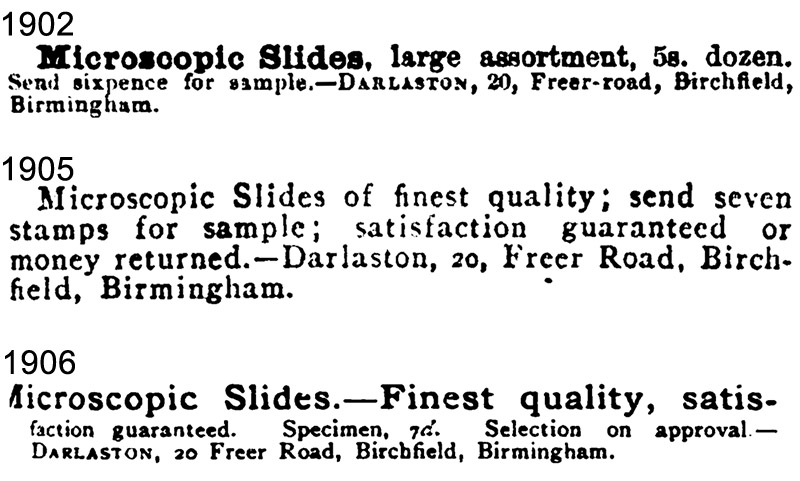
Figure 6.
Early advertisements from Darlaston for his microscope slides: 1902, from “The English Mechanic and World of Science”, when he was a clerk and slide-making was a part-time job; 1905, from “Country-Side”, around the time he began preparing slides full-time; and 1906, from “Nature”.
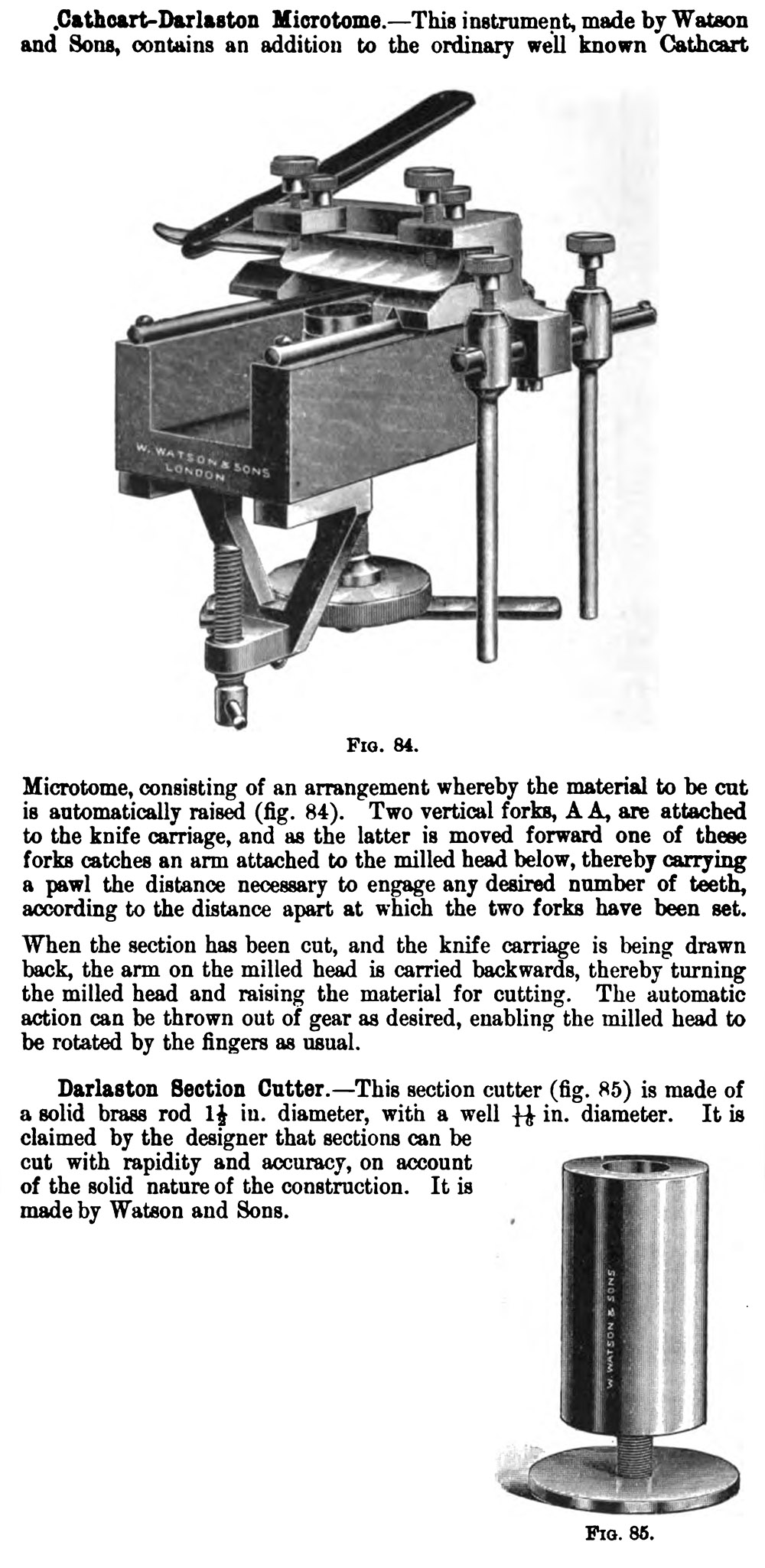
Figure 7.
1906 illustrations and descriptions of the Cathcart-Darlaston microtome and the Darlaston section-cutter, both manufactured by W. Watson & Sons. From “The Journal of the Royal Microscopical Society”.
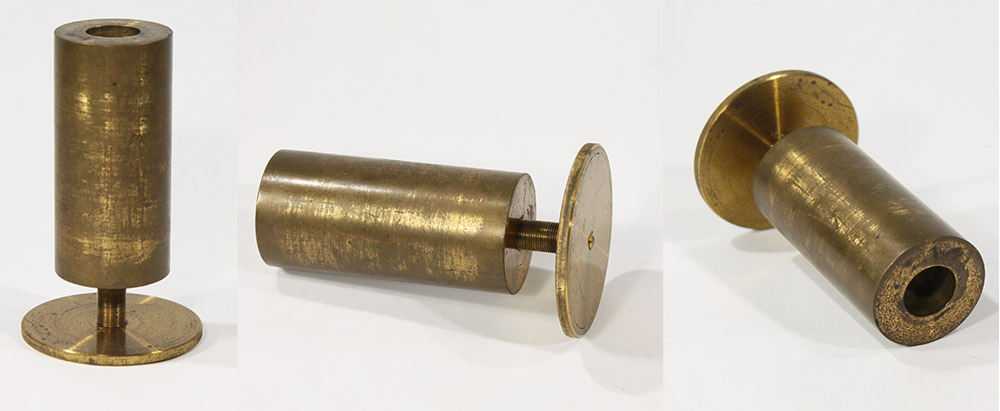
Figure 7B.
A "Darlaston section cutter", for use in preparing thin sections of botanicals, etc. for mounting on microscope slides (see Figure 7).
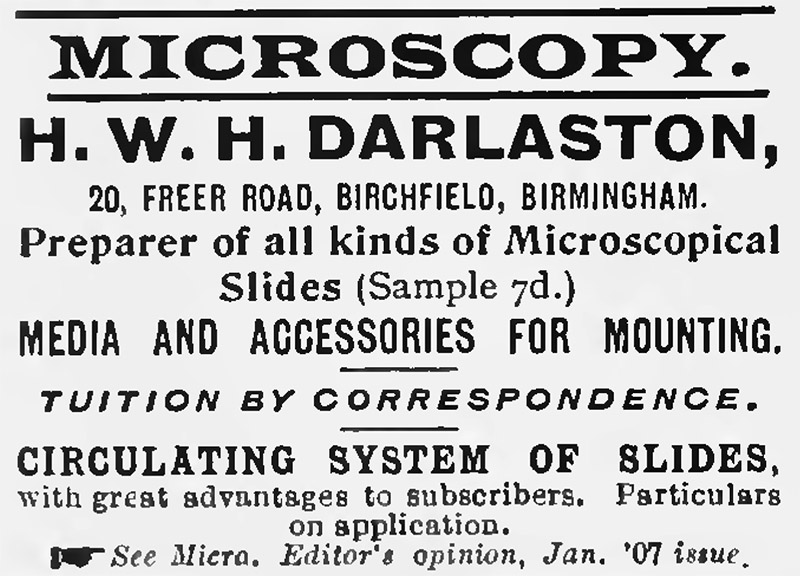
Figure 8.
1907 advertisement, from “Knowledge and Illustrated Scientific News”.

Figure 9.
1908 advertisement, from “Country-Side”. Darlaston’s ad was published directly above that of another Birmingham-area slide-maker, Edward G. Howard.
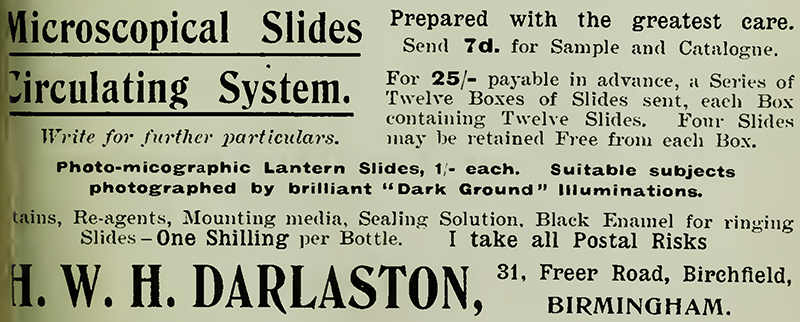
Figure 10.
1910 advertisement, from “The Annual Report of the Liverpool Microscopical Society”.
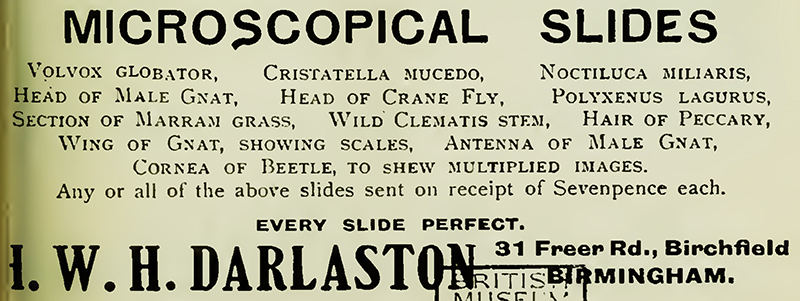
Figure 11.
1917 advertisement, from “The Annual Report of the Liverpool Microscopical Society”.
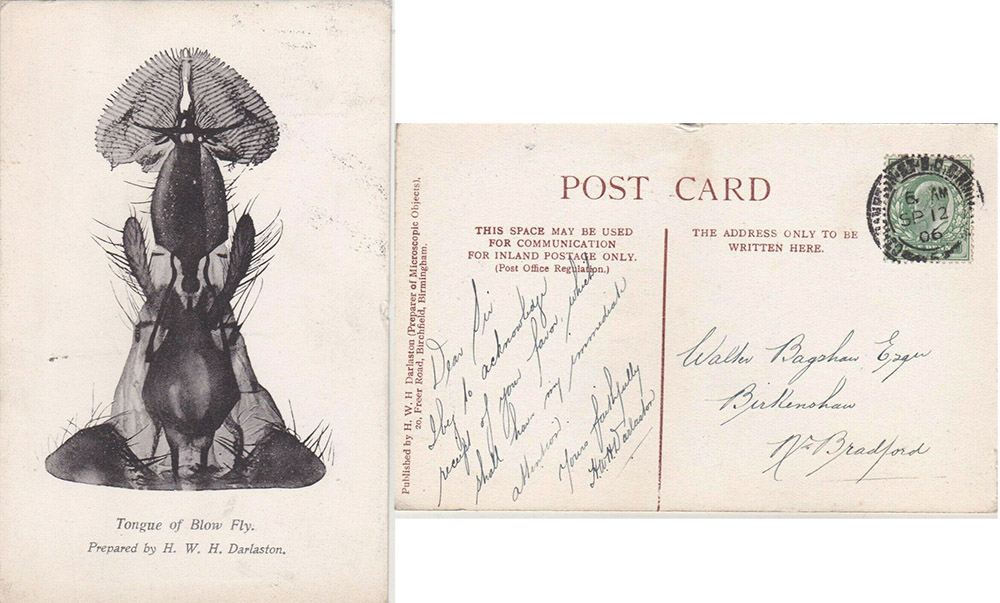
Figure 12.
A postcard that was produced by Darlaston. The picture is a blow fly’s proboscis. The message was written and signed by Darlaston. Postmarked 1906. Adapted for nonprofit, educational purposes from an internet auction site.

Figure 13.
The handwriting looks familiar. Herbert Darlaston may have produced slides for other retailers, such as the major Birmingham microscope-manufacturing firm of Philip Harris.
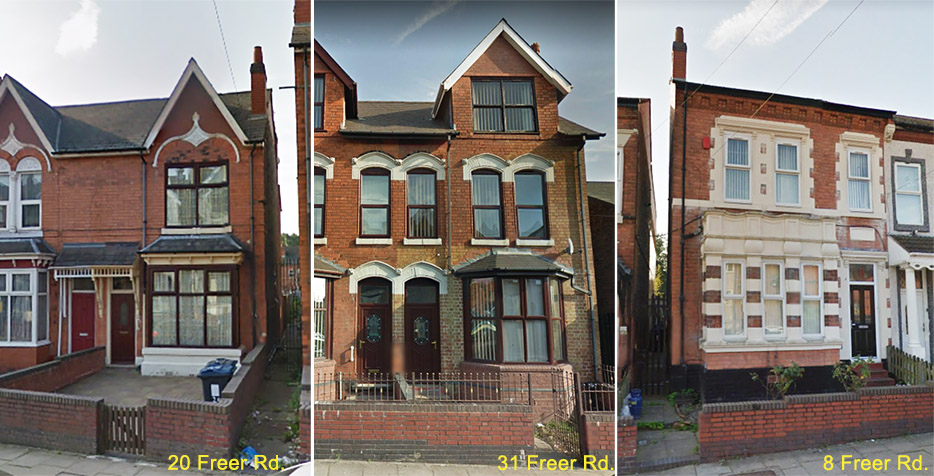
Figure 14.
Views of Darlaston family homes on Freer Road: number 20 (1902-1907), number 31 (1908-1939) and number 8 (1940-1949). Herbert operated his slide-making business from these houses. From 1903 to ca. 1906, he also ran a used book shop at 20 Freer Road. The houses at #20 and #31, at least, were rented by the Darlastons. Adapted for nonprofit, educational purposes from Google Street-View images.
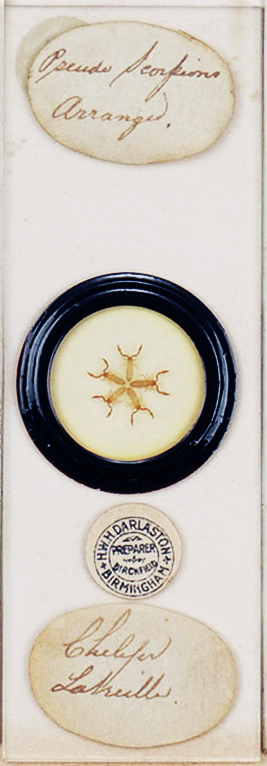
Figure 15.
An unusual slide: an arrangement of five whole Chelifer latreille pseudoscorpions. Adapted for nonprofit, educational purposes from an internet auction site.
Acknowledgements
Thank you to Mike Samworth for providing copies of articles on Darlaston from The Microscope and The Balsam Post, and to Trevor Gillingwater, Richard Courtiour, and Peter Hodds for sharing images.
Resources
Annual Report of the Liverpool Microscopical Society (1910) Advertisement from H.W.H. Darlaston, Vol. 40
Annual Report of the Liverpool Microscopical Society (1917) Advertisement from H.W.H. Darlaston, Vol. 48
Bracegirdle, Brian (1998) Microscopical Mounts and Mounters, Quekett Microscopical Club, London, pages 29 and 132, and Plates 14-H, 14-J, 14-K, and 14-L
The Book Monthly (1903) Vol. 1, page 287
The Book Monthly (1904) Vol. 1, page 676
Christening record of Herbert W.H. Darlaston (1867) Parish records of St. Anne, Aston Brook (Warwickshire), accessed through ancestry.com
Clegg, James (1906) “Hutton, William, 20 Freer road, Birchfield, 1903, Secondhand”, The International Directory of Booksellers and Bibliophile’s Manual, Aldine Press, Rochdale, page 6
Corrington, Julian D. (1942) Working with the Microscope, Whittlesey House, New York, pages 203-204
Country-Side (1905) Advertisement from H.W.H. Darlaston, September 9 issue
Country-Side (1908) Advertisement from H.W.H. Darlaston, February 8 issue
Darlaston, H.W.H. (1895) Query: Crane-flies from aquatic pupae, The Entomologist's Record and Journal of Variation, Vol. 7, page 17
England and Wales Register (1939) H.W.H. Darlaston, wife, and eldest daughter at 31 Freer Road. His occupation is described as “Pre’ Microscopical Slides”, accessed through ancestry.com
England census and other records, accessed through ancestry.com
The English Mechanic and World of Science (1902) Advertisement from H.W.H. Darlaston, December 5 issue
Horril, L.E. (1952) H.W.H. Darlaston and J.W. Neville, The Microscope, Vol. 8, page 52
Journal of the British Astronomical Association (1900) “New Members of the Association, Elected, 28th November 1900, Herbert William Hutton Darlaston, 16, Fentham Road, Birchfield, Birmingham”, Vol. 11, page 93
Journal of the Quekett Microscopical Club (1909) List of members
Journal of the Royal Microscopical Society (1906) Cathcart-Darlaston microtome and Darlaston section-cutter, pages 734-735
Kelly’s Directory of Birmingham (1899) “Darlaston Herbert W.H. 10 Fentham road, Birchfield”, page 117
Kelly’s Directory of Birmingham (1903) “Darlaston Herbert W.H. 20 Freer road, Birchfield”, page 349
Kelly’s Directory of Birmingham (1905) “Freer road, Birchfield: 20, Darlaston Herbert W.H.; 20, Hutton William, second hand book seller”, page 117
Kelly’s Directory of Birmingham (1940) “Darlaston Herbert William Hutton, preparer of microscopic objects, 8 Freer road, Birchfield 6”, page 117
Knowledge and Illustrated Scientific News (1906) The Cathcart-Darlaston microtome, New series, Vol. 3, page 597
Knowledge and Illustrated Scientific News (1907) Microscope slides, New series, Vol. 4, page 22
Knowledge and Illustrated Scientific News (1907) Advertisement from H.W.H. Darlaston, New series, Vol. 4, March issue
Loxton, F.C. (1992) H.W.H. Darlaston, The Balsam Post, pages 7-8, quoting from S.N. Sedgwick, The Young People's Microscope Book, originally published in 1911
The Naturalists' Directory (1914) “Darlaston, H. W. H., 31 Freer Rd., Birchfield, Birmingham. Preparer of Microscopic slides; subjects, Anatomy, Bot., Ent., Pond Life, Diatoms and General Ent., Bot., Zool.”, S.E. Cassino, Boston, USA, page 142
Nature (1906) Advertisement from H.W.H. Darlaston, March 8 issue
Peacock, Alan H. (1940) Elementary Microtechnique, E. Arnold & Co., London, page 296
Probate of the will of H.W.H. Darlaston (1949) “Darlaston Herbert William Hutton of 8 Freer-road Birchfield Birmingham 6 died 4 March 1949 at 1 Western-road Birmingham 18 Probate Birmingham 30 May to Edith May Darlaston widow. Effects £851 6s 11d”, accessed through ancestry.com
Spence, D.S. (1950) From my notebook, The Microscope, Vol. 7, pages 327-328
W. Watson & Sons Catalogue of Microscopes and Accessories (1912) Cathcart-Darlaston microtome, page 134
The Year-book of the Scientific and Learned Societies of Great Britain and Ireland (1893) Vol. 10, pages 103-104
The Year-book of the Scientific and Learned Societies of Great Britain and Ireland (1895) Vol. 12, page 105